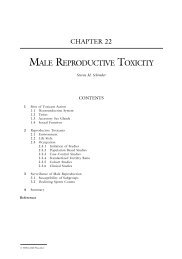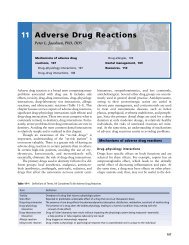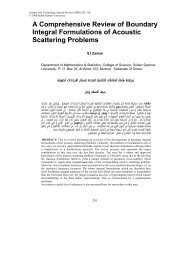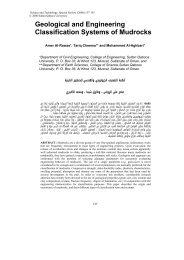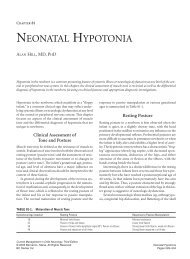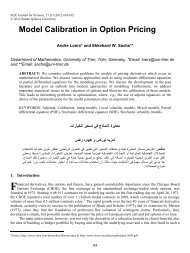Ch05: Red and White Lesions of the Oral Mucosa
Ch05: Red and White Lesions of the Oral Mucosa
Ch05: Red and White Lesions of the Oral Mucosa
You also want an ePaper? Increase the reach of your titles
YUMPU automatically turns print PDFs into web optimized ePapers that Google loves.
<strong>Red</strong> <strong>and</strong> <strong>White</strong> <strong>Lesions</strong> <strong>of</strong> <strong>the</strong> <strong>Oral</strong> <strong>Mucosa</strong> 89<br />
FIGURE 5-5 Extensive tissue necrosis caused by injudicious use <strong>of</strong> silver<br />
nitrate.<br />
Hydrogen Peroxide. Hydrogen peroxide is <strong>of</strong>ten used as an<br />
intraoral rinse for <strong>the</strong> prevention <strong>of</strong> periodontal disease. At<br />
concentrations <strong>of</strong> ≥ 3%, hydrogen peroxide is associated with<br />
epi<strong>the</strong>lial necrosis. 40<br />
Sodium Hypochlorite. Sodium hypochlorite, or dental<br />
bleach, is commonly used as a root canal irrigant <strong>and</strong> may<br />
cause serious ulcerations due to accidental contact with oral<br />
s<strong>of</strong>t tissues. 32<br />
Dentifrices <strong>and</strong> Mouthwashes. Several cases <strong>of</strong> oral injuries<br />
<strong>and</strong> ulcerations due to <strong>the</strong> misuse <strong>of</strong> commercially available<br />
mouthwashes <strong>and</strong> dentifrices have been reported (Figure 5-<br />
6). 31,33,42,47 An unusual sensitivity reaction with severe ulcerations<br />
<strong>and</strong> sloughing <strong>of</strong> <strong>the</strong> mucosa has been reported to have<br />
been caused by a cinnamon-flavored dentifrice (Figure 5-7).<br />
However, <strong>the</strong>se lesions probably represent a sensitivity or allergic<br />
reaction to <strong>the</strong> cinnamon aldehyde in <strong>the</strong> toothpaste. 47<br />
This reaction can appear to be very similar to <strong>the</strong> reactions<br />
caused by o<strong>the</strong>r chemical agents such as aspirin <strong>and</strong> hydrogen<br />
FIGURE 5-6 Diffuse slough <strong>of</strong> marginal gingivae due to misuse <strong>of</strong> commercial<br />
mouthwash.<br />
FIGURE 5-7 Severe ulceration <strong>and</strong> sloughing <strong>of</strong> mucosa, caused by use<br />
<strong>of</strong> a cinnamon-containing dentifrice.<br />
peroxide. Caustic burns <strong>of</strong> <strong>the</strong> lips, mouth, <strong>and</strong> tongue have<br />
been seen in patients who use mouthwashes containing alcohol<br />
<strong>and</strong> chlorhexidine. 33,42 A case <strong>of</strong> an unusual chemical<br />
burn, confined to <strong>the</strong> masticatory mucosa <strong>and</strong> produced by<br />
abusive ingestion <strong>of</strong> fresh fruit <strong>and</strong> by <strong>the</strong> concomitant excessive<br />
use <strong>of</strong> mouthwash, has also been reported. 42<br />
TYPICAL FEATURES<br />
The lesions are usually located on <strong>the</strong> mucobuccal fold area<br />
<strong>and</strong> gingiva. The injured area is irregular in shape, white, covered<br />
with a pseudomembrane, <strong>and</strong> very painful. The area <strong>of</strong><br />
involvement may be extensive. When contact with <strong>the</strong> tissue is<br />
brief, a superficial white <strong>and</strong> wrinkled appearance without<br />
resultant necrosis is usually seen. Long-term contact (usually<br />
with aspirin, sodium hypochlorite, phenol, paraformaldehyde,<br />
etc) can cause severer damage <strong>and</strong> sloughing <strong>of</strong> <strong>the</strong> necrotic<br />
mucosa. The unattached nonkeratinized tissue is more commonly<br />
affected than <strong>the</strong> attached mucosa.<br />
TREATMENT AND PROGNOSIS<br />
The best treatment <strong>of</strong> chemical burns <strong>of</strong> <strong>the</strong> oral cavity is prevention.<br />
Children especially should be supervised while taking<br />
aspirin tablets, to prevent prolonged retention <strong>of</strong> <strong>the</strong> agent in<br />
<strong>the</strong> oral cavity. 31,41,45 The proper use <strong>of</strong> a rubber dam during<br />
endodontic procedures reduces <strong>the</strong> risk <strong>of</strong> iatrogenic chemical<br />
burns. Most superficial burns heal within 1 or 2 weeks. A<br />
protective emollient agent such as a film <strong>of</strong> methyl cellulose<br />
may provide relief. 37,45 However, deep-tissue burns <strong>and</strong> necrosis<br />
may require careful débridement <strong>of</strong> <strong>the</strong> surface, followed by<br />
antibiotic coverage. In case <strong>of</strong> ingestion <strong>of</strong> caustic chemicals or<br />
accidental exposure to severely corrosive agents, extensive scarring<br />
that may require surgery <strong>and</strong>/or pros<strong>the</strong>tic rehabilitation<br />
may occur. 48<br />
Actinic Keratosis (Cheilitis)<br />
Actinic (or solar) keratosis is a premalignant epi<strong>the</strong>lial lesion<br />
that is directly related to long-term sun exposure. 49 These<br />
lesions are classically found on <strong>the</strong> vermilion border <strong>of</strong> <strong>the</strong>





